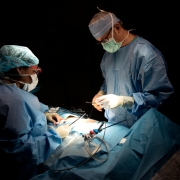Spine and Becker’s Spine Review recently touched on whether or not the microscope in minimally invasive surgery makes a difference. The two publications provided data concluding that the use of a microscope (slightly) increased the average operating room time and had comparable infection rates to those not using a microscope. Results can be seen below.
*Results from Spine Journal study:
23,670 elective spine procedures identified.
2226 (9.4%) used an operating microscope.
Average patient age was 55.1 ± 14.4 years.
Average operative time (incision to closure): 125.7 ± 82.0 minutes.
Microscope use was associated with minor increases in preoperative room time (+2.9 min), operative time (+13.2 min), and total room time (+18.6 min) on multivariate analysis.
A total of 328 (1.4%) patients had an infection within 30 days of surgery. Analysis revealed no significant difference between microscope and non-microscope procedures for occurrence of infection.
“Conclusion. We did not find operating room times or infection risk to be significant deterrents for use of an operating microscope during spine surgery.”
Having worked in the medical industry for a number of years, the team at NeuroMicroSpine found this study quite interesting. Although evidence from a select group of patients slightly proves otherwise, history has demonstrated that without the use of microscopic surgical techniques among other technological advancements, spine surgery wouldn’t be nearly as quick or cost-effective.
 To start, the use of a microscope eliminates a surgeon’s need to make a large incision (5 to 6 inches). This is important because with larger incisions comes significant complications; open surgeries, as alluded to in the “Open Spine Surgery vs. Minimally Invasive Surgery” blog post, can cause extensive muscular injury during surgery and atrophy, pain and spasm afterward.
To start, the use of a microscope eliminates a surgeon’s need to make a large incision (5 to 6 inches). This is important because with larger incisions comes significant complications; open surgeries, as alluded to in the “Open Spine Surgery vs. Minimally Invasive Surgery” blog post, can cause extensive muscular injury during surgery and atrophy, pain and spasm afterward.
Because the microscope aids in the minimally invasive approach, postoperative results require less narcotic use (less pain is reported with MIS surgeries) as compared to the open surgery technique.
Yes, the study concluded that there weren’t significant differences in the two surgery types; well, with a few facts and other extensive data, it's safe to assume the use of a microscope seemly provides more good than harm.
For more information on minimally invasive spine surgery or to make an appointment with Dr. Giovanini, please call (850) 934-7545 or visit http://www.neuromicrospine.com/request-appointment. We hope to see you soon!
The advice and information contained in this article is for educational purposes only, and is not intended to replace or counter a physician’s advice or judgment. Please always consult your physician before taking any advice learned here or in any other educational medical material.
© NeuroMicroSpine, 2014
© Medical Marketing Solutions, 2014
*Study source: http://journals.lww.com/spinejournal/Abstract/2014/10150/Use_of_an_Opera...
